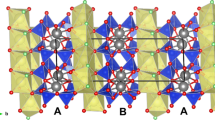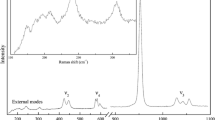Abstract
Powder IR spectra of synthetic richterite-tremolite and Sr-tremolite-tremolite solid solutions were obtained in the spectral range between 1400 and 600 cm−1. Under the consideration of the crystal structure and the Wykoff positions of the atoms in the primitive unit cell, the number, type and symmetry of vibrational modes were deduced. The space group of tremolite C2h was used as the factor group leading to 16 theoretical stretching vibrations in the IR range caused by the Si4O11 ∞-ribbon. The energy of the internal vibrations of the Si4O11 ∞-ribbon is a function of the relative bond strengths and masses of nearby ions. For the amphiboles a one-mode behavior was observed for all the Si-O, Si-O-Si and O-Si-O stretching vibrations, indicating no clustering in the two solid solution series. In both solid solution series the vibrational energy of the stretching vibrations is a linear function of composition. In the system richterite-tremolite a shift of the stretching frequencies of the Si4O11 ∞-ribbon over the whole compositional range of up to 30 cm−1 was observed. In contrast, for Sr-tremolite-tremolite the maximum shift was only 5 cm−1. These quite small band shifts allow the (Si4O11)∞-ribbon to be treated as an isolated entity for factor group analysis. Nevertheless, by the two exchange mechanisms, Ca(M4) ? Sr(M4) and □(A) Ca(M4) ? Na(A)Na(M4), the FWHHs increased and the amplitudes decreased, indicating a slight distortion of the ribbon. For Sr-tremolite-tremolite only a linear expansion of the lattice was observed. In the series richterite-tremolite individual bond angles of the SiO4 tetrahedra are additionally changed, causing the higher energy shift of the bands. The strongest and sharpest bands were observed for the end member tremolite. The one-mode behavior of the Si4O11-double chain indicates that there is no short-range order of Na/Ca and Ca/Sr at the M4 sites of these amphiboles.
Similar content being viewed by others
Author information
Authors and Affiliations
Additional information
Received: 7 December 1998 / Revised, accepted: 29 October 1999
Rights and permissions
About this article
Cite this article
Andrut, M., Gottschalk, M., Melzer, S. et al. Lattice vibrational modes in synthetic tremolite-Sr-tremolite and tremolite-richterite solid solutions. Phys Chem Min 27, 301–309 (2000). https://doi.org/10.1007/s002690050259
Issue Date:
DOI: https://doi.org/10.1007/s002690050259




